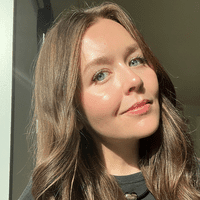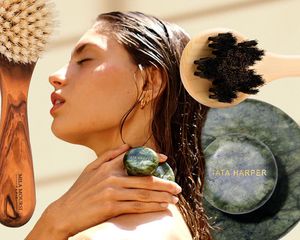I received my official, clinical insomnia diagnosis when I was 21. That was four years ago now—but at the time, I romanticized my sleep disorder as a way to cope. I bragged about being able to pull all-nighters in my college library. I self-branded myself as a night owl and made fun of my friends when they went to bed before 2 a.m. I rattled off my memorized list of creative geniuses like Voltaire and Da Vinci who notoriously never slept. (I'm not this annoying now—promise.)
But behind the scenes, I was punching my pillow. And staring at the ceiling. And smearing away tears when my alarm went off—because I couldn't remember if I'd even slept a wink. I got by on a prescription from my doctor for awhile, but it suppressed my personality and gave me intolerable brain fog. Once, during my first week on the medication, I bought a plane ticket to Norfolk, England instead of my hometown airport (Norfolk, Virginia) while I was half asleep. That, and the acute need to throw up would wake me up every other morning.
I know this sounds like a depressing story to be classified as a brain hug, but I promise I'm getting to the happy ending.
I eventually found some peace (and sleep) after discovering meditation during a meditation training retreat in the Bahamas in January 2020. But this past October, when I really started to feel the weight of the election and the pandemic, my insomnia returned in full force. By the beginning of October, after spending almost seven months confined to my tiny New York City apartment, I was getting the worst sleep of my life (read as: none).
I found myself deep in an internet rabbit hole—you guessed it, in the middle of the night—where I discovered an insomniacs Reddit thread about people having sleep success using a form of meditation called "forest bathing." Users were claiming this meditation technique, which originated in Japan, was helping them fall asleep faster, stay asleep through the night, and actually wake up feeling well-rested (what a concept). Always open-minded, I put in my time-off request at work and booked my own forest bathing experience at a retreat in the Catskills just an hour and a half's drive from my apartment: Mohonk Mountain House. Ahead, I detail my experience.
What Is Forest Bathing?
Forest Bathing is a form of meditation that originates in Japan, where the practice is called shinrin-yoku. (Shirin means forest and yoku means bath.) But despite the English translation, there isn't any bathing involved—at least not in the traditional sense. Instead of sinking into a literal bathtub, you immerse yourself in nature.
"Forest bathing is about opening up all five senses to fully absorb the nature around you," as Nina Smiley, Ph.D—a psychologist, meditation expert, and Mohonk's director of mindfulness programming—told me. "I also call forest bathing 'mindfulness in nature.' During this meditative walk, we invite nature to permeate all five senses, and it brings an overall sense of well-being and calm."
Studies backup Smiley's claims. According to this 2017 study conducted in transcontinental Japan and China, forest bathing has been shown to improve anxiety, sleep quality, and "human feelings of 'awe' (an increase in gratitude and selflessness)." All things I could use as a boost in the current climate.
:max_bytes(200000):strip_icc()/EMBED-1-InsomniaBathWoods-ea0dbbfe263e455d826bbc054d0b6572.jpg)
Retreat Day One
On the first day of my retreat, I met Smiley in one of Mohonk's "summer houses"—wooden gazebos perched in the forest that overlook Lake Mohonk—where she coached me on what to expect. I tucked away my cell phone and we spent 15 minutes practicing how to engage the senses one by one until I was ready to use them simultaneously. I closed my eyes and smelled the mountain air. Then I added the sense of touch and felt the knots in the wood of the summer house. Then I listened to the leaves whisper in the wind, and the rowboats knocking together below. Smiley instructed me to unclench my jaw, to release my tongue from the roof of my mouth and taste the cold air. Finally, the last sense—Smiley told me to open my eyes, and I experienced complete sensory overload from the same scenery that felt very much neutral before. Actively introducing my senses to my surroundings one at a time made everything bigger, brighter... just more.
After that brief primer, we headed into the woods to begin our forest bathing session, which would last 45 minutes. Walking through the woods, Smiley coached me back into a meditative state. We walked very slowly—a challenge for me, a Manhattan resident—and paused frequently for focused meditation. Smiley would have me choose a leaf on a tree that I thought was beautiful or an interesting rock formation and stare at it until my mind would clear. Then I'd follow a ripple in the lake until it reached the shore, or feel a flower petal between my fingers.
To be honest, I felt pretty silly at first. But once I let go of my inhibitions, I started to feel more present. I noticed patterns deep within petals of flowers that I've looked at all my life—and heard forest sounds I'd never taken the time to pay attention to before. After what felt like 10 minutes at most, Smiley let me know that our 45 minute session had ended. Our session flew by, and I can genuinely say that after just 45 minutes of actively connecting my senses to the forest around me, I felt an overwhelming sense of euphoric calm, despite the chaos of the world, and I carried that feeling for the rest of the day.
As for going to bed that night—well, I actually slept. I tucked myself into bed prepared for another sleepless night, but instead of just staring at the ceiling, I tried to use the mindfulness techniques from my forest bathing session. I closed my eyes, squished the plush comforter, wiggled my toes between the sheets, listened to the crickets outside, and before I could remember what the fifth sense was, I slipped into sleep.
:max_bytes(200000):strip_icc()/EMBED-2-InsomniaBathWoods-72f9534c44274faf8e87a7528536968b.jpg)
Retreat Day Two
The morning of day two, I was actually startled to find that I'd slept through the night. (To put that into context, the last time I slept through the night, the CDC had not yet recommended that we wear masks.) But I knew I had a potentially challenging day ahead of me—I'd have to forest bathe on my own, without Smiley's guidance (or her soothing nature documentary voice that made it seem so easy).
As part of my retreat itinerary, I started the day with an aromatherapy massage to prime myself for forest bathing (anything for the sake of mastering meditation, right?). This was, of course, after the massage therapist and I both received a negative COVID test, passed our temperature tests, and wore masks throughout the duration of my treatment.
While Smiley laid the sensorial foundation during my training session, the massage therapist would help me work on my awareness of bodily tension and breathwork. To start, she mixed up a blend of eucalyptus and lavender oils and spritzed the face hole on the massage table so I could practice breathing with a repetitive cadence during the massage, which can help you reach a deeper meditative state. I'd inhale deeply through my nose, then release my breath through my mouth with each pulse of her palm on my back. Later, I'd apply this breathing technique to my forest bathing, tacking it on to what I'd already learned about opening up my senses.
I left the treatment room feeling lighter than air. And normally, I'd leave the spa right away and resume my normal pace (which, as sad as it sounds, is a bit like hitting a fast forward button on life). But in the spirit of being mindful, I sat by the fire and practiced working each sense one by one, coupled with the breathing technique I learned during my treatment. Eyes closed, I breathed in and took in the crackle of the fire, feeling the cozy fabric of my spa robe giving me a warm hug. I paused life for a minute and just took a moment to be grateful to have an entire spa lounge to myself (the room I was in was completely empty since the spa has social distancing rules in place).
And when it was time for me to forest bathe on my own, I was ready. I made my way to the top of the mountain trail, moving as slowly as possible and stopping whenever I saw something interesting I wanted to spend some time with. When I made it to the top, the same sense of euphoria I'd felt on the first day returned. I felt completely open, completely at peace, and completely in the present moment.
That night, I fell asleep before 9 p.m. and woke up around 11 the next morning—a full 14 hours of sleep.
What Happened After I Left Mohonk
If I told you I've had a perfect night's sleep and have been in an incredible mood every day since leaving Mohonk, I'd be lying. But the meditation techniques I learned in just two days have empowered me to know that I can disrupt that fast forward button and hit pause every now and then (and that for my mental health, it's okay to do that). When the news is too heavy and I feel like I'm drowning, I have the tools to pull myself out and put myself somewhere else, even for just a minute. And the more I practice doing this, the easier it is for me to tap into that feeling when it's time to fall asleep.
Since I don't live in the mountains, I practice forest bathing with what I do have access to, and I'm so grateful for it. I take weekly walks in Central Park, and each time I invite myself to open up my senses and connect with the nature around me. I actively challenge myself to engage all of my senses and really experience the environment around me. I synchronize my breathing to my steps.
On an even smaller scale, sometimes I forest bathe with my houseplants. (It sounds silly, but it works.) Instead of just dumping a shot glass full of water on my succulents every other week, I take time to feel the soil, mist the leaves, inspect new growth, and tilt them toward the sunlight.
I close my eyes, feel the leaves between my fingers, and for a moment I can transport myself somewhere else. And these days, somewhere else is a very nice place to be.
:max_bytes(150000):strip_icc()/landingpage_hero_desktop_FINAL20201116-b44f94cf2bac44b89a3f6f4176199a47.jpg)
:max_bytes(150000):strip_icc()/LandingPg-BSide-2x-8f9a096781ee457790b0c57600ba2cc0.png)
:max_bytes(150000):strip_icc()/Friendships-Falling-Apart-RECIRC-b405f95c2d734fab9188097eee4b76aa.jpg)
:max_bytes(150000):strip_icc()/RECIRC-Emotional-Makeup-1ba026986abf4548bcff55b923ccacdb.jpg)
:max_bytes(200000):strip_icc()/SF-Holly-Insomnia1-e44b1f623df648838cc0337cb30725da.jpg)



